Intel Core i7 3960X (Sandy Bridge E) Review: Keeping the High End Alive
by Anand Lal Shimpi on November 14, 2011 3:01 AM EST- Posted in
- CPUs
- Intel
- Core i7
- Sandy Bridge
- Sandy Bridge E
Windows 7 Application Performance
3dsmax 9
Today's desktop processors are more than fast enough to do professional level 3D rendering at home. To look at performance under 3dsmax we ran the SPECapc 3dsmax 8 benchmark (only the CPU rendering tests) under 3dsmax 9 SP1. The results reported are the rendering composite scores.
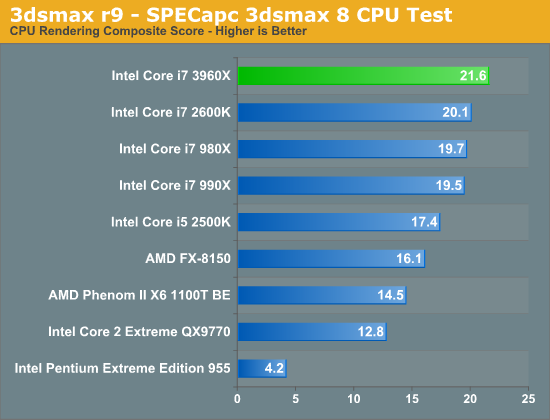
Offline 3D rendering applications make some of the best use of CPU cores, unfortunately our test here doesn't scale all that well. We only see a 7% increase over the 2600K. If we look at a more modern 3D workload however...
Cinebench 11.5
Created by the Cinema 4D folks we have Cinebench, a popular 3D rendering benchmark that gives us both single and multi-threaded 3D rendering results.
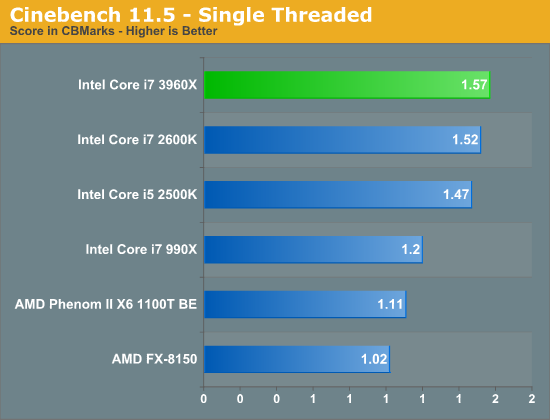
Single threaded performance is marginally better than the 2600K thanks to the 3960X's slightly higher max turbo speed. What's more important than the performance here is the fact that the 3960X is able to properly power gate all idle cores and give a single core full reign of the chip's TDP. Turbo is alive and well in SNB-E, just as it was in Sandy Bridge.
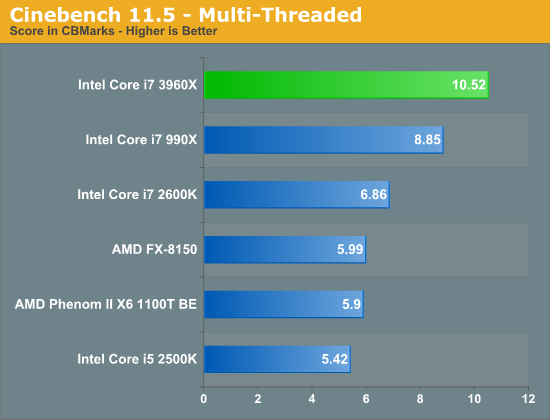
Here the performance gains are staggering. The 3960X is 53% faster than the 2600K and 19% faster than Intel's previous 6-core flagship, the 990X. The Bulldozer comparison is almost unfair, the 3960X is 75% faster (granted it is also multiple times the price of the FX-8150).
7-Zip Benchmark
While Cinebench shows us multithreaded floating point performance, the 7-zip benchmark gives us an indication of multithreaded integer performance:

Here we see huge gains over the 2600K (58%), indicating that the increase in cache size and memory bandwidth help the boost in core count a bit here. The advantage over the 990X is only 7%. This gives us a bit of a preview of what we can expect from SNB-EP Xeon server performance.
PAR2 Benchmark
Par2 is an application used for reconstructing downloaded archives. It can generate parity data from a given archive and later use it to recover the archive
Chuchusoft took the source code of par2cmdline 0.4 and parallelized it using Intel’s Threading Building Blocks 2.1. The result is a version of par2cmdline that can spawn multiple threads to repair par2 archives. For this test we took a 708MB archive, corrupted nearly 60MB of it, and used the multithreaded par2cmdline to recover it. The scores reported are the repair and recover time in seconds.
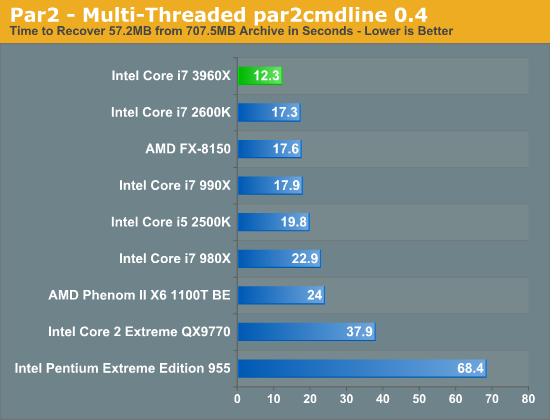
Here we see a 40% increase in performance over the 2600K and FX-8150.
TrueCrypt Benchmark
TrueCrypt is a very popular encryption package that offers full AES-NI support. The application also features a built-in encryption benchmark that we can use to measure CPU performance with:
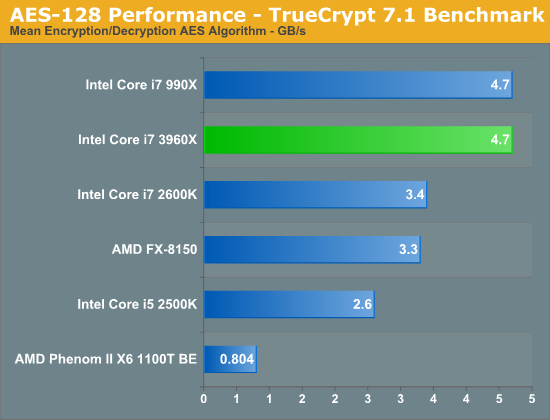
As both the 990X and 3960X have AES-NI support, both are equally capable at cranking through an AES workload. Per core performance doesn't appear to have changed all that much with the move to Sandy Bridge, so here we have a situation where the 3960X is much faster than the 2600K but no faster than the 990X. I suspect these types of scenarios will be fairly rare.
x264 HD 3.03 Benchmark
Graysky's x264 HD test uses x264 to encode a 4Mbps 720p MPEG-2 source. The focus here is on quality rather than speed, thus the benchmark uses a 2-pass encode and reports the average frame rate in each pass.
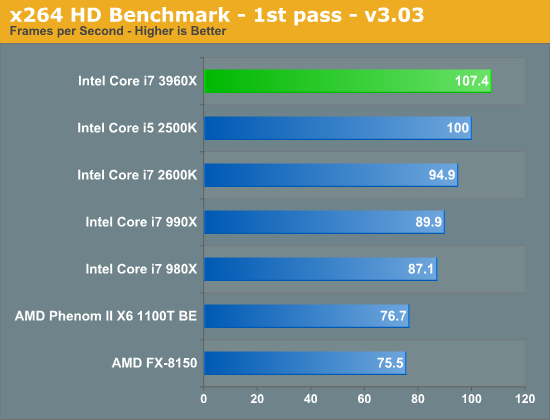
Single threaded performance isn't significantly faster than your run-of-the-mill Sandy Bridge, which means the first x264 HD pass doesn't look all that impressive on SNB-E.
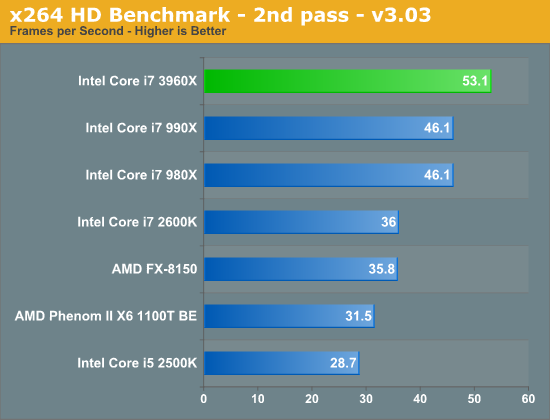
The second pass however stresses all six cores far more readily, resulting in a 47.5% increase in performance over the 2600K. Even compared to the 990X there's a 15% increase in performance.
Adobe Photoshop CS4
To measure performance under Photoshop CS4 we turn to the Retouch Artists’ Speed Test. The test does basic photo editing; there are a couple of color space conversions, many layer creations, color curve adjustment, image and canvas size adjustment, unsharp mask, and finally a gaussian blur performed on the entire image.
The whole process is timed and thanks to the use of Intel's X25-M SSD as our test bed hard drive, performance is far more predictable than back when we used to test on mechanical disks.
Time is reported in seconds and the lower numbers mean better performance. The test is multithreaded and can hit all four cores in a quad-core machine.
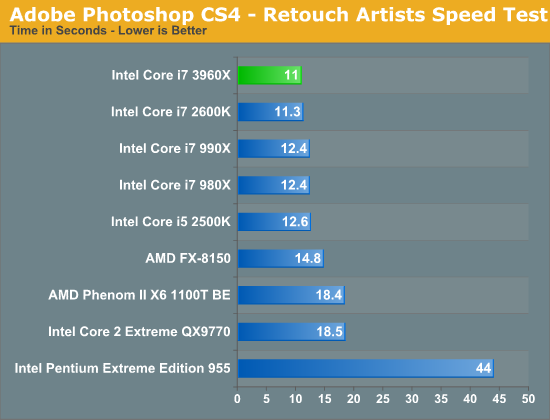
Our Photoshop test is multithreaded but there are only spikes that use more than four cores. That combined with the short duration of the benchmark shows no real advantage to the 3960X over the 2600K. Sandy Bridge E is faster than Intel's old 6-core solution though.
Compile Chromium Test
You guys asked for it and finally I have something I feel is a good software build test. Using Visual Studio 2008 I'm compiling Chromium. It's a pretty huge project that takes over forty minutes to compile from the command line on the Core i3 2100. But the results are repeatable and the compile process will stress all 12 threads at 100% for almost the entire time on a 980X so it works for me.
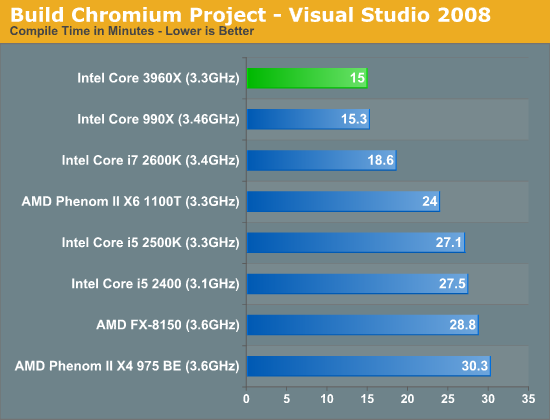
Our compile test is extremely well threaded, which once again does well on the 3960X. The gains aren't as big as what we saw in some of our earlier 3D/transcoding tests, but if you're looking to build the fastest development workstation you'll want a Sandy Bridge E.
Excel Monte Carlo
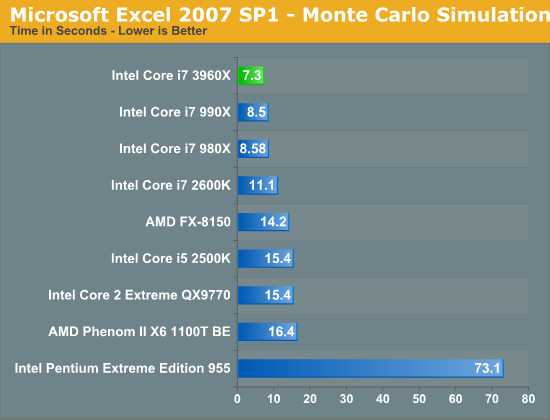
Multithreaded compute does well on SNB-E regardless of the type of application. Excel is multithreaded and if you have a beefy enough workload, you'll see huge gains over the 2600K.










163 Comments
View All Comments
Zak - Monday, November 14, 2011 - link
I want native USB3 plus significantly higher number of PCIe channels so I can run two cards at full 16x and a decent RAID controller at 4x without having to pay over $300 for the mobo. Oh, and for god's sake say goodbye to the PCI slots please while improving the motherboard layout so dual slot cards don't cover any available PCIe slots.Bullshit like "Three PCIe x16 slots!!!! (running at 8x, 8x, 2x) make me sick. The latest Intel motherboards were rather underwhelming in terms of features.
chizow - Monday, November 14, 2011 - link
It really seems as if Intel wants to kill off this high-end enthusiast desktop segment completely; what we have here is a by-product of their server market and perhaps the last of a dying breed. First sign was the change to multiple sockets and locking clock frequency on their non-enthusiast parts. Also, SB-E comes with a huge increase in platform cost compared to Nehalem that doesn't really justify the increase in performance over SB.$500 for the entry-level SB-E CPU and $300+ for the motherboard is going to be a bitter pill to swallow for those used to the $200-$300 entry-level Nehalem CPUs and $200 boards. I know there's going to be a 4-core part that may be closer to that price point sometime next year, but again, one has to ask if it will be worthwhile over a 2600K at that point, especially since the K is unlocked and the SB-E part isn't.
Also factor in the reality PCIE 3.0 is going to be a negligible benefit of the chipset. Maybe if ATI/Nvidia's next-gen GPUs make use of the extra bandwidth. You also don't get any additional benefits in the way of SATA or USB support compared to last-gen SB products....its really quite disappointing for a chipset that was held off this long.
Overall the performance looks good, but at the price and size....is this the path CPUs are headed for? Huge and hot like GPUs? I mean we thought Bulldozer was massive, SB-E is just as big but at least it delivers when it comes to performance I guess. I can see why Intel wanted to bifurcate their server/desktop business, but I think the unfortunate casualty will be the high-end enthusiast market that don't want to pay e"X"treme prices for the privelege.
redisnidma - Monday, November 14, 2011 - link
Looking at these results, you have to wander what in the world was AMD thinking when they designed Bulldozer (AKA Crapdozer).Feel sorry for them. :(
just4U - Monday, November 14, 2011 - link
For the most part Amd's bulldozer did give us 2500K speeds.. and multithreaded performance is there. This cpu is the fastest we've seen but it certainly doesn't blow one away in comparison to the 2600K. The Amd CPU is criticized for one thing really.. it's single threaded performance which is no better then it's cheapest proccessors.Guspaz - Monday, November 14, 2011 - link
A minor performance boost in most real-world scenarios, and yet a massive increase in cost and power consumption...This whole chip is basically a big kludge. Take an 8-core Xeon and disable a quarter of the chip, slap a "consumer" label on it, and call it a day? That's not even trying, that's just lazy.
This chip is 50% faster than SNB in heavily multithreaded applications because it has 50% more cores. A much more interesting chip would have been to take the existing SandyBridge chips and increase the core count, rather than taking a Xeon and disabling parts of the core.
EJ257 - Monday, November 14, 2011 - link
Actually isn't that basically what they did with this? They took 8 SB cores and threw it on the die, took out the IGP and dropped in a massive L3 cache. I mean if your going to be building a gaming rig based on SB-E, would you actually care about the IGP at that point when you got SLI or X-Fire GPUs?I understand how this move would make some people feel like they've been slapped in the face by Intel. Years as loyal customers and this time around they get a "crippled" part to call a flagship. Look at what the state of the high end CPU market is like. At this point Intel is dominating and there is really no incentive for them to do a completely different chip when a "crippled" Xeon can run circles around the best AMD has to offer. From their point of view this is the most economic way to do business. But yes, meh indeed when you already have a i7 2600K running smoothly.
adamantinepiggy - Monday, November 14, 2011 - link
Or will there be a desktop version again without ECC support and a workstation Xeon version that does? (890x/990x vs x5680 Xeon) I'll take ECC support for RAM over faster RAM with eight populated slots please. The larger and larger memory amounts means more likelihood of bit errors, but for two generations of CPU's from Intel, no EEC RAM support on the CPU memory controller.hechacker1 - Monday, November 14, 2011 - link
I agree. With massive amounts of memory that you could potentially put onto this platform, I'd really like to have a version with ECC for the workstation.BSMonitor - Monday, November 14, 2011 - link
I understand the need to keep news positive for AMD. Competition and all. However, repeatedly stating over time that they are competitive on price is kind of misleading in the grand scheme. Each new CPU arch. from Intel yields double digit performance gains(lately). AMD's are often delayed and in BD's case yield backwards results in many benchmarks.The truth is, clock for clock, given as many transistors, given as much power and heat, AMD is grossly not competitive.
The ONLY reason one can say that their chips are competitive in relation to price, is that they have NO other choice but to sell them at that price. AMD looks at where it's new CPU's relate in terms of performance to Intel's lineup and price accordingly. As many R&D $$, transistors, etc that go into each FX-8150, the flagship CPU should be at least competing with the 2600K, 990X, etc of the world. Forcing either Intel either to lower the $1000 tag on SNB-E or allowing AMD a $1000 alternative.
However, all we get from AMD is mediocre, late to market attempts to "catch-up". My point, AMD needs a new infusion of engineers and/or new approach. A complete new idea/redesign/etc..
Let's face it, the x86 market is now Intel x86. Perhaps, AMD should take what it knows in processor design and embrace a new idea.. Maybe a mixed ARM/x86 or an enhanced ARM 64-bit for desktop PCs. Something to stand out and deliver on. Pure x86, AMD is falling further behind. BD did not even catch up to 4 core SNB. And Ivy Bridge is being held back, as there is no really competition for it. The landscape looks like AMD will be out of the desktop CPU space within a year or two. Or at least religated to Cyrix status from the 2000's.
bji - Monday, November 14, 2011 - link
Your point about AMD's prices don't make any sense. You're saying that AMD is not a good value because it is selling its chips at a price that makes them a good value rather than making faster chips and selling them for more money like Intel does?!?Since when does "a good price:performance ratio" not equal "a good value" just because the CPU vendor doesn't have high (or any!) profit margins?